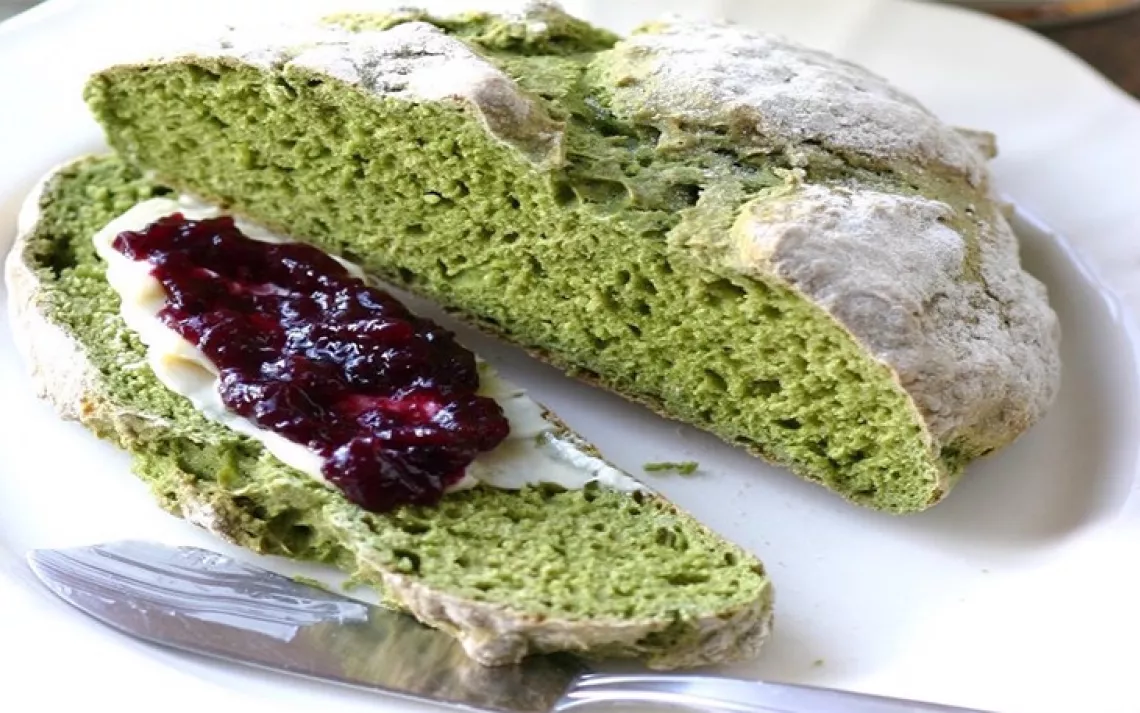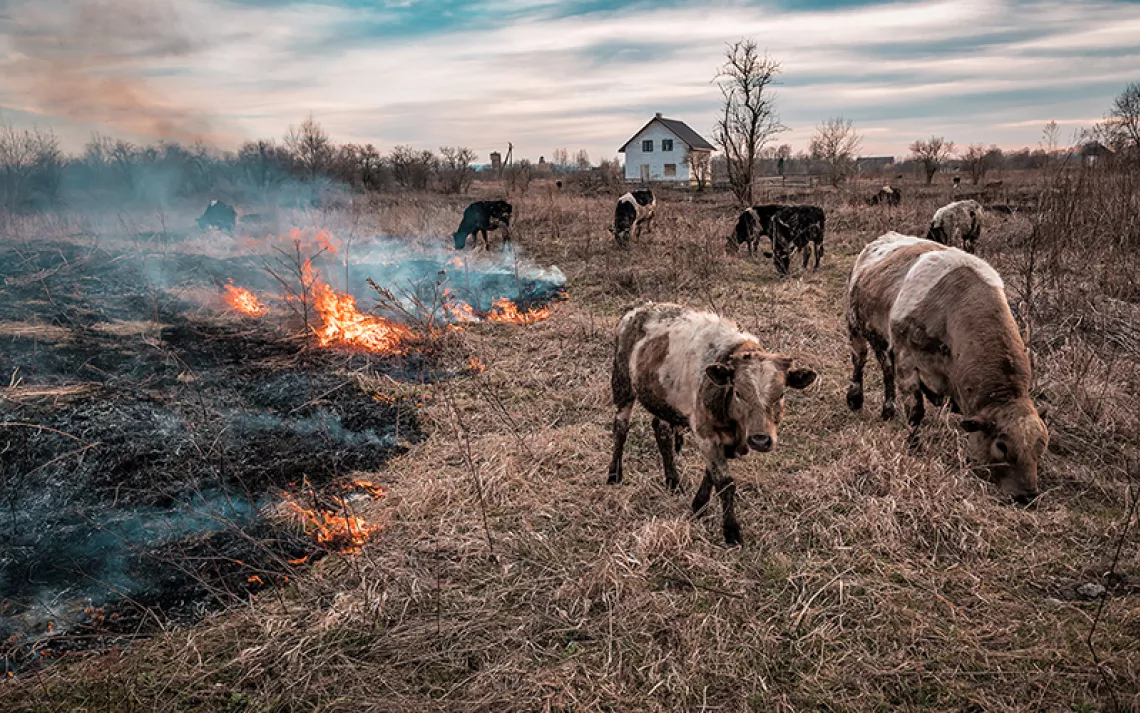Plan a Plant-Based Year of the Ox
Usher in Lunar New Year with five Asian food bloggers’ fave vegan recipes
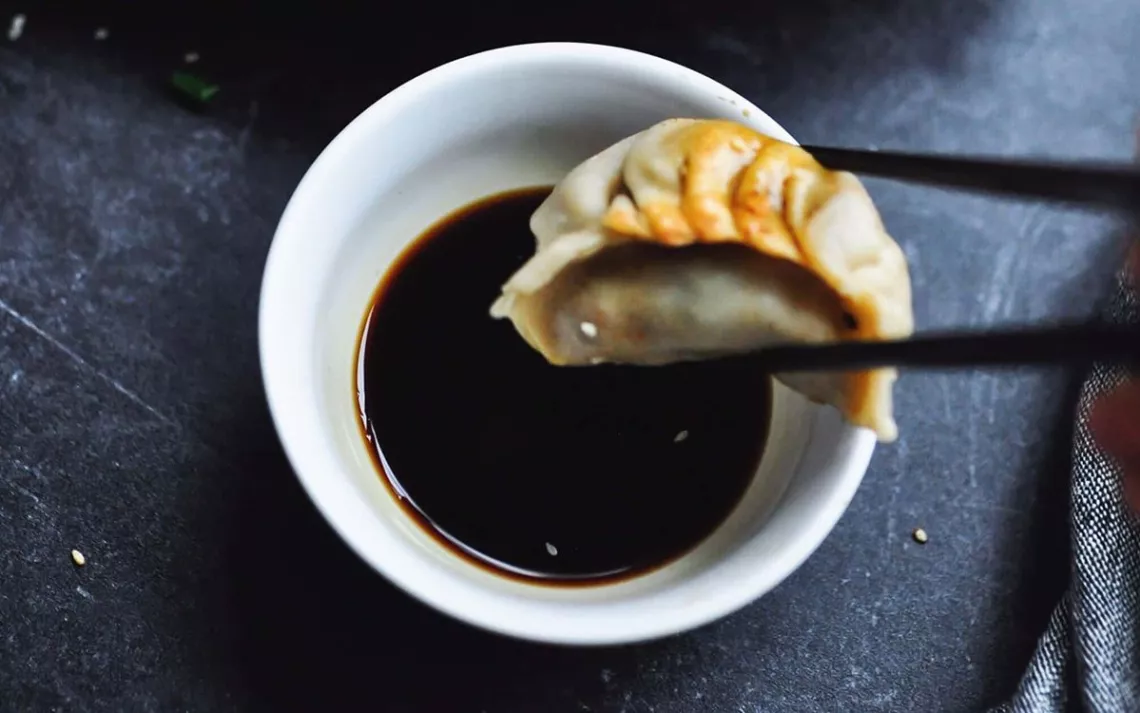
In China, South Korea, Vietnam, and other East Asian countries, February 12 marks the start of the Lunar New Year. Also known as Spring Festival, the first new moon of the lunisolar calendar marks the celebration of new beginnings. It’s a time when families typically convene—often traveling long distances—to share a delicious meal believed to bring good fortune.
The Year of the Ox kickoff, however, looks a lot different. With COVID-19 still rampant and travel restrictions disrupting family gatherings around the world, Asians are forced to reckon with tradition—starting with what’s on the dinner table.
Sierra spoke with five food bloggers who are reimagining—and veganizing—Lunar New Year culinary traditions. They shared what it’s like to embrace a plant-based diet in meat-centric cultures—and also provided recipes that blend cultural tradition with eco-sustainability and animal welfare.
Joanne Molinaro, also known as “The Korean Vegan” (Chicago)
After a sobering awakening to the meat industry’s carbon impact, as well as an uptick in family health issues, Joanne Molinaro switched to a plant-based diet six years ago. Since then, she’s launched The Korean Vegan, a blog that showcases Korean-style vegan dishes through original recipes and storytelling. The blog has since expanded to Instagram, YouTube, and a TikTok channel that have amassed a total of more than 2 million fans. Molinaro is also working on a cookbook.
Despite her rise, Molinaro’s veganism remains a point of contention in her family. When she first made the plant-based switch, Molinaro’s parents’ initial reaction was so strong that her mother did not invite her to the family’s annual Lunar New Year dinner, reasoning that they didn’t prepare food she could eat. She was crushed.
Over time, fortunately, her family warmed up to her plant-based lifestyle. She now brings vegan dishes to their Lunar New Year dinner that remain true to Korean culinary traditions. One of them is tteokguk, a sliced rice cake soup originally made with beef broth. (Koreans believe that the more rice cakes you eat, the more blessings you receive.) "I can veganize almost anything," she says.
Here’s Molinaro’s recipe for GF Kimchi Pancakes: “This is a tweak from my prior recipe for gluten-free pancakes. By adding a little kimchi juice and chunks of overripe kimchi to the batter, you guarantee a kimchi explosion with every bite!”
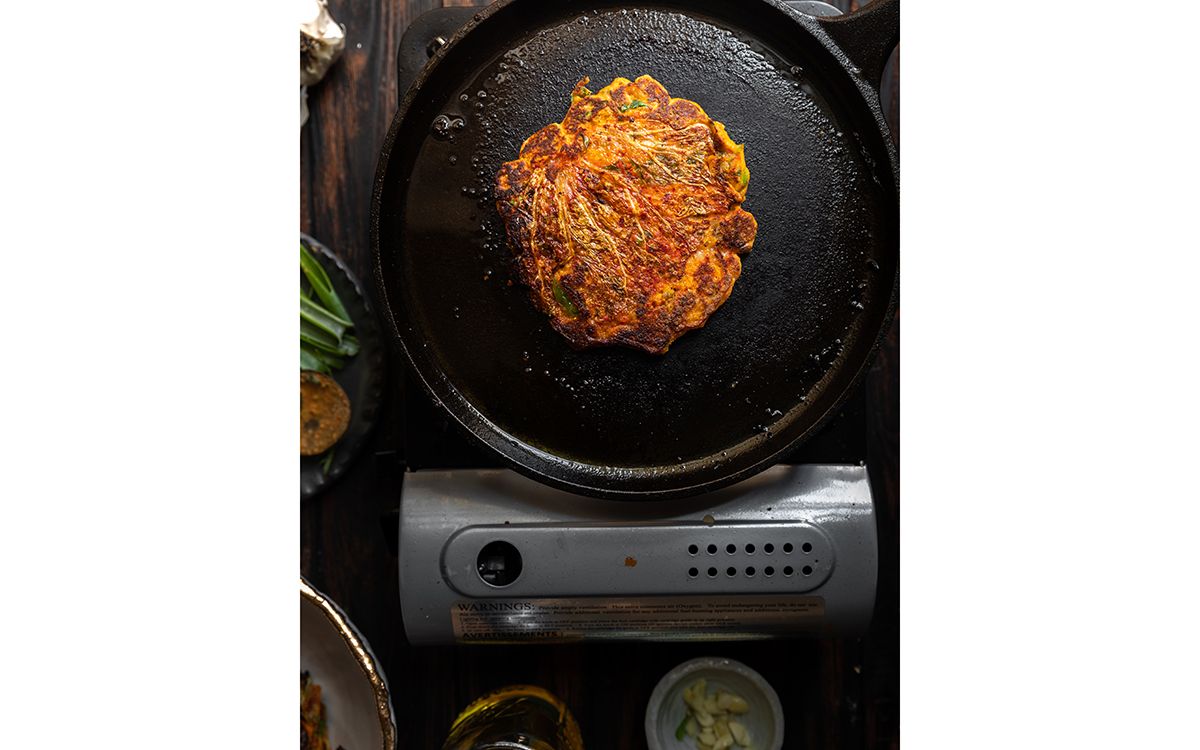
Yield: 8 pancakes
INGREDIENTS
Pancakes
-
1 tbsp white wine vinegar
-
3/4 cup nondairy milk
-
1/2 cup blanched almond flour (almond meal will result in less fluffy pancakes)
-
1/2 cup sweet white rice flour (do not replace with regular white rice flour)
-
2 tbsp cornmeal
-
1/4 cup potato starch
-
2 tsp baking powder
-
1/2 tsp baking soda
-
1 tsp salt
-
1 tbsp garlic powder
-
1 tbsp onion powder
-
2 scallion whites chopped
-
2 scallion greens (julienned)
-
1 Korean green chili (sliced)
-
3 cloves garlic (sliced and minced)
-
1 cup kale (cut into ribbons)
-
1/2 cup overripe kimchi (plus more for topping)
-
1 tsp kimchi juice
Dressing
-
1/4 cup soy sauce (tamari is a GF soy sauce)
-
1 tsp maple syrup
-
1 tsp rice wine vinegar
-
1 tbsp mirin
-
1 tbsp sesame seeds
-
1/2 jalapeno or Fresno chili pepper (seeded and thinly sliced)
-
1 tbsp garlic (minced)
-
1 tbsp Korean pepper powder (optional)
INSTRUCTIONS
-
Stir white wine vinegar into nondairy milk and set aside. In a large bowl, mix together all dry ingredients with a whisk or fork.
-
Add minced garlic (half of your garlic should be minced and the other half should be thinly sliced, which you will save for "toppings"), the chopped scallion whites, half of the Korean green chili, and the kale to the dry ingredients.
-
Add 1/2 cup of overripe kimchi, as well as 1 to 2 teaspoons of kimchi juice. Using a pair of kitchen shears, snip up the kimchi into bite-size pieces (you can also chop the kimchi in advance, but it always makes a mess).
-
Add in nondairy milk mixture and whisk until the dry ingredients are fully incorporated. The batter will be very thick (almost like cake batter), but if it's too thick to work with, add 1 tablespoon of nondairy milk at a time until it gets to a workable consistency.
-
Add a little oil to a skillet (I use a cast-iron skillet) to medium-high heat. When the pan is hot, add some scallion greens, sliced garlic, and/or kimchi directly to the pan. Then, pour a small ladleful (about 3 tablespoons) of batter.
-
Lower the heat to medium-low and cook for about 1 1/2 to 2 minutes before flipping. Cook until both sides are evenly browned and serve with the dressing (which you make just by mixing all the ingredients together).
Hannah Che, also known as “The Plant-Based Wok” (Taiwan)
Growing up in a health-conscious family, Hannah Che always ate largely plant-based meals. But when she became more familiar with the ethical concerns surrounding meat consumption, she decided to go vegan. After numerous friends asked her to share what she eats, she documented her meals on Instagram, which has now accumulated more than 135,000 followers. She also started the vegan Chinese recipe blog The Plant-Based Wok and is working on her debut cookbook.
As a Chinese American born and raised in Michigan, Che feared the switch to a plant-based diet would alienate herself from Chinese culture. But as she dove into the centuries-long legacy of veganism in Chinese cuisine, she quickly realized that a vegan lifestyle offered an opportunity for cultural reconnection.
“For Western vegetarianism, it's almost like an ideology or a personal choice that you make,” Che told Sierra. “It's very much dependent on your own convictions. But for the Chinese tradition of vegetarian eating, it's tied to fasting and purity rules from Buddhism.”
Che doesn’t have a set of Lunar New Year traditions. When she celebrated with family, meals would often be an assortment of American and Chinese dishes; some were home-cooked and others takeout. Nonetheless, dumplings and sweet rice cakes were always on the table.
Here are Che’s Vegan Potstickers (pan-fried dumplings)—Chinese potstickers filled with a delicious mushroom and vegetable filling. "Pan-fried and then steamed, these dumplings are packed with flavor, with golden-brown, crispy bottoms."
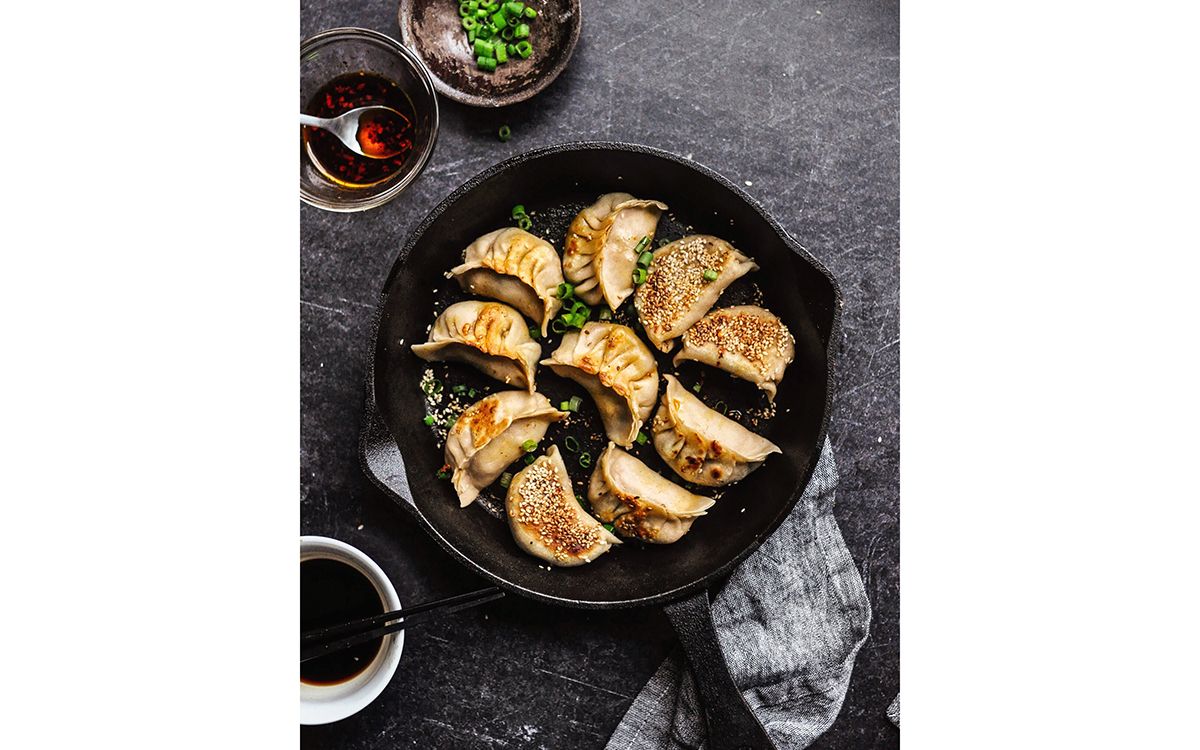
Prep Time: 60 minutes
Cook Time: 30 minutes
Yield: 4 dishes
INGREDIENTS
Wrappers:
-
3 cups (390g) all-purpose flour
-
1/4 tsp salt
-
1 cup boiling water + 1 tbsp cold water
Filling:
-
2 tbsp finely chopped ginger
-
1 medium onion, finely chopped
-
3 cups shiitake mushrooms, finely chopped
-
2 tbsp vegetable oil
-
2 cups finely shredded cabbage
-
1 1/2 cups finely shredded carrot
-
4 scallions (around 1 cup), finely chopped, both white and green parts
Seasoning:
-
1 tbsp sesame oil
-
3 tbsp Shaoxing wine or rice wine
-
2 tbsp soy sauce
-
1 tsp sugar
-
1/4 tsp ground white pepper
-
1 tsp salt, to taste
INSTRUCTIONS
-
To make dough: Combine the flour and salt in a medium bowl. Make a well in the center and gradually add the boiling water, stirring with a spoon until the mixture forms clumps. Cover and let rest for 5 minutes. Add 1 tbsp cold water and knead into a ball, then cover and let rest as you prepare the filling.
-
To make filling: Heat oil in a large wok or skillet over medium-high heat and stir-fry ginger and onions until translucent. Add in chopped mushrooms and stir-fry for another 3 to 5 minutes until liquid is evaporated, then add cabbage and carrots and stir-fry for 3 to 4 minutes, until most of the liquid from the vegetables is released. Add chives, wine, soy sauce, sugar, white pepper, and salt, and cook 1 more minute, then remove from heat. Taste and add more salt or sesame oil as necessary (you want the filling to be quite salty/well-seasoned, as the flavor mellows in the dumplings). Place filling in the fridge to cool.
-
To make the dumplings: Divide the dough into two portions and knead well. Roll each portion into a one-inch rope and cut into small tablespoon-size pieces, flattening each piece with the palm of your hand. Dust the working surface with flour and roll each piece out into a flat disc. Add a generous amount of filling and pleat the edges, pinching tightly to seal.
-
Heat a tablespoon of oil in a nonstick pan over medium-high heat, then place the dumplings in the pan and allow to fry for 2 minutes. Pour 1/4 cup (or a thin layer) of water into the pan, cover, and reduce heat to medium-low. Allow dumplings to steam until the water has evaporated, then remove the cover, increase heat to medium-high and fry for a few more minutes, until the bottoms of the dumplings are golden brown and crisp. Serve immediately.
NOTES
-
I used fresh shiitake mushrooms. You could also use other varieties, but I recommend shiitake mushrooms as they have the most flavor.
-
Instead of shredding the cabbage and carrots by hand, I simply chop them into rough chunks and process them in a food processor a few times.
-
If you have access to Chinese chives, use them instead of scallions!
-
Don't skimp on the oil for this recipe—it's important for the flavor and mimics the fattiness of traditional meat dumplings.
-
To freeze, place the uncooked potstickers on a tray for 30 minutes to freeze individually, then store in a freezer bag.
WoonHeng Chia (Texas)
Growing up in Malaysia, WoonHeng Chia was raised to believe that meat is the crux of a balanced diet. When she became a vegetarian as a teenager, her family refused to accept it. After years of relentless determination, she convinced them that an entirely plant-based diet is possible (her mother is now a vegetarian). Chia now runs an Asian-influenced vegan food blog and Instagram account with more than 370,000 followers. She’s also a recipe resident at Food52.
Since she moved to the US, Chia hasn’t celebrated Lunar New Year with family. However, she continues to carry on familial culinary traditions, with, of course, a vegan spin. Using tofu, tempeh, mushrooms, and beans as meat substitutes, Chia says it’s easy to veganize the popular Malaysian dishes she grew up eating.
Prior to the pandemic, Chia celebrated by holding a potluck with friends, where they’d cook together and play games. From her husband’s family, she’s also adopted a Chinese tea ceremony tradition, wherein kids pay respect to their parents, wishing good fortune before they receive their red envelopes. This year, Chia will be organizing a virtual Lunar New Year celebration, during which she plans on cooking taro fish, pineapple tarts, and a Buddhist-inspired vegetable stir-fry for prosperity and health.
“With a few creative changes, you can enjoy the same meal without harming any animals,” Chia told Sierra.
Here’s Chia’s Easy Mushrooms Stir-Fry, which she describes as a “super simple and quick mushroom stir-fry that you can toss together with just a few simple ingredients for a delicious and flavorful meal.”
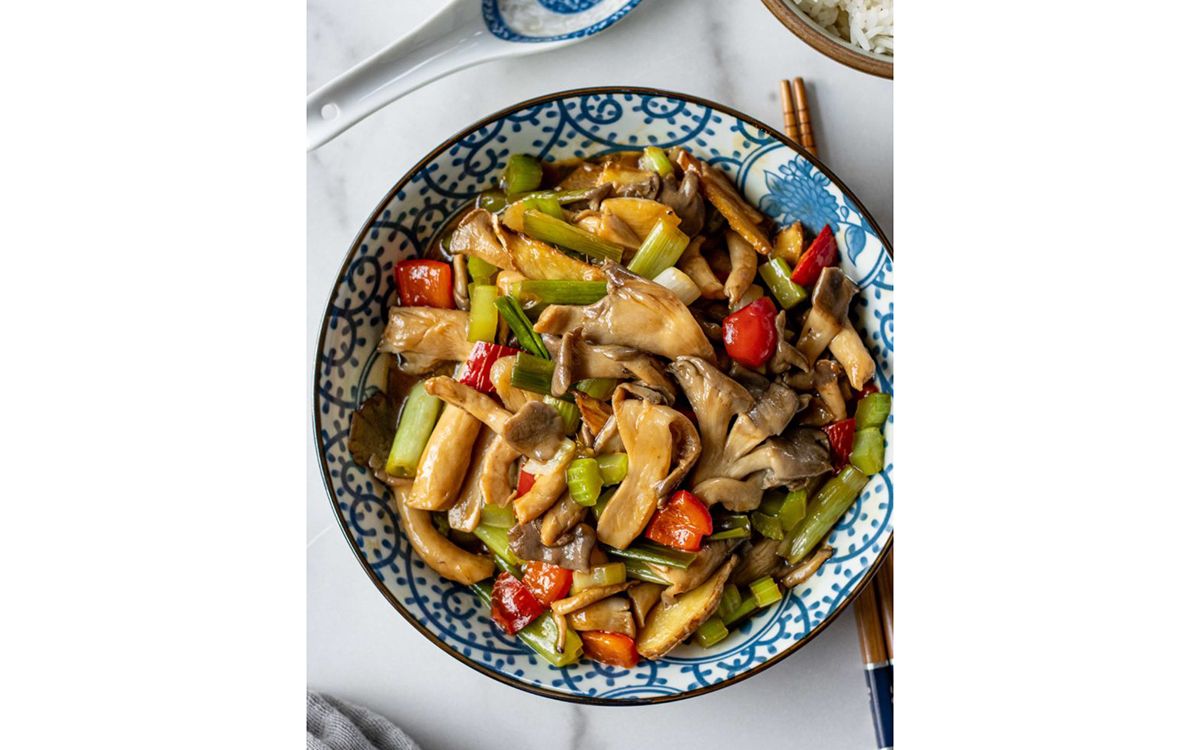
Prep Time: 10 mins
Cook Time: 10 mins
Stir-Fry Servings: 2
INGREDIENTS
-
10 oz (300g) fresh mushrooms of choice (I used Oyster mushrooms)
-
1 celery stalk chopped
-
2 stalks green onion chopped
-
1 knob thumb-size ginger sliced
-
3 cloves garlic sliced
-
1 red jalapeno sliced
-
oil for cooking
-
salt to taste
Sauce:
-
1 tsp lime juice from a lime wedge
-
1 tbsp light soy sauce or tamari
-
1 tbsp homemade stir-fry sauce or vegan oyster sauce
-
1 tbsp cooking wine or michiu optional or sub with water
-
1 tsp sugar
Cornstarch slurry (mix until well combined):
-
¼ cup (65g) water
-
1 tsp cornstarch
INSTRUCTIONS
-
Clean mushrooms with a damp paper towel or a pastry brush to remove dirt and tear them into smaller pieces.
-
Heat a nonstick pan with 1 tablespoon of oil and sauté ginger until it turns golden brown. Then, continue to sauté garlic until aromatic.
-
Add in the mushrooms and stir-fry for a minute or two until they're slightly browned or when you can smell the aroma of the mushrooms.
-
Add in the rest of the vegetables along and with the sauces, swirl in the cornstarch slurry, and remove from heat.
-
Serve warm with rice.
NOTES
-
For the homemade vegan oyster sauce, you can try all-purpose umami seasoning.
-
If using store-bought vegan oyster sauce, adjust the saltiness accordingly.
-
For other fresh mushrooms that release more moisture, adjust the cornstarch slurry accordingly.
Christine Wong, of “Conscious Cooking” (New York City)
Christine Wong’s transition into veganism was seamless—throughout her life, she slowly eliminated meat from her diet. It was after attending the Institute of Integrative Nutrition, though, that Wong became an advocate for prioritizing vegetables in daily meals. She now runs Conscious Cooking, a vegan food blog and Instagram channel, and is the author of the cookbook The Plantiful Plate: Vegan Recipes From the Yomme Kitchen.
Wong’s favorite part of her Lunar New Year culinary traditions? The symbolism that accompanies the food. Every year, she gathers “lucky” fresh ingredients, cooking noodles for longevity, for instance, and dumplings for wealth.
Before the pandemic, Wong celebrated the new year with a small, intimate gathering of family and friends. Fish and duck were still at the table, but Wong introduced vegan dishes such as turnip cakes, mushroom bao, and veggie dumplings.
“A lot of Chinese dishes require minimal meat,“ Wong told Sierra. “I think it’s important to rethink what’s traditional, and to be able to enjoy celebrations in more sustainable ways.”
Here’s her recipe for Turnip Cake (lo bak go): “One of my favorite dim sum dishes, I usually only make turnip cake at home during Lunar New Year.”
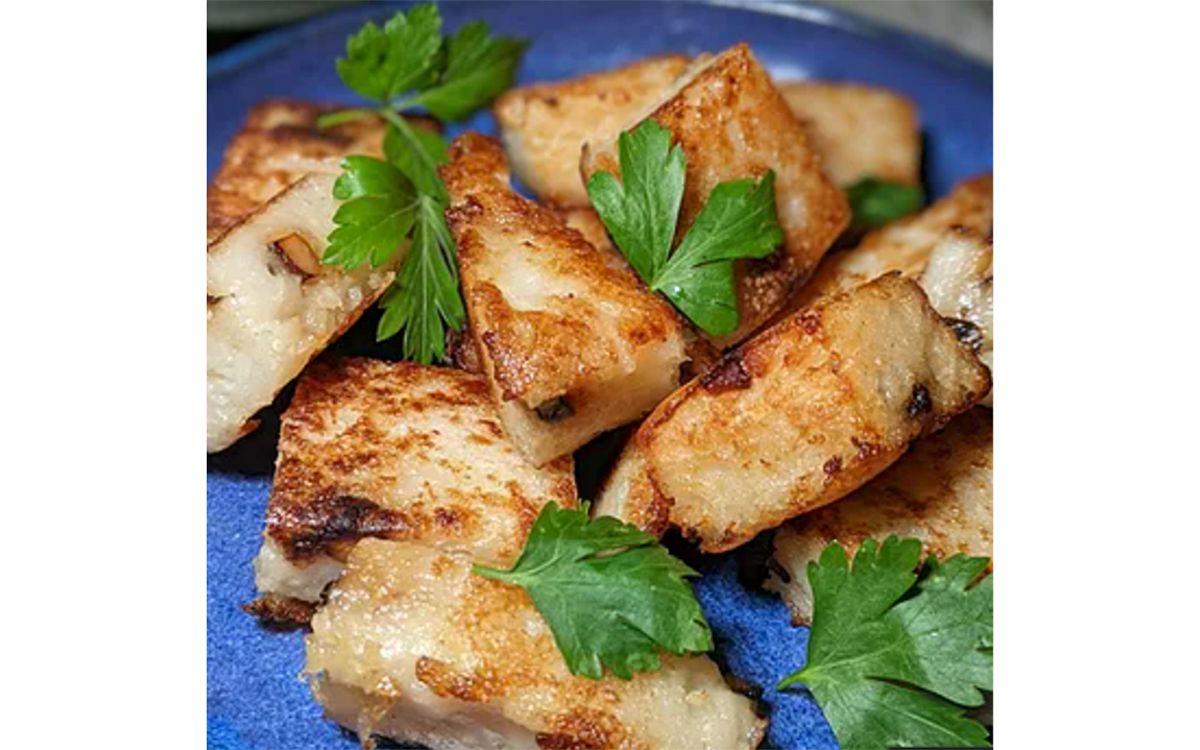
INGREDIENTS
-
1 lb (450g) Gilfeather heirloom turnips (white) or one large daikon
-
1 tsp sugar
-
3 tbsp oil, divided
-
3 tbsp spring garlic or ramps, finely chopped
-
1/4 lb (125g) shiitake or king oyster mushrooms, diced
-
1 tsp soy sauce
-
1/2 tsp smoked paprika
-
1 cup (150g) rice flour
-
1 tbsp cornstarch
-
1 tsp salt
-
1/8 tsp white pepper
-
3/4 to 1 cup (180 to 240ml) room temperature water or strained daikon water
INSTRUCTIONS
-
Coarsely grate the turnips and toss with sugar.
-
Heat a frying pan up with one tablespoon of oil. Sauté the turnips and sugar for 5 minutes until softened. Transfer to a plate to cool. Daikon holds more water, so if using this root vegetable, squeeze out the liquid after pan-frying and use this excess liquid as part of the water to make the batter or else the batter will be too watery.
-
Add a little more oil and saute the green garlic and mushrooms for 5 minutes. Season with the smoked paprika and soy sauce. Cook until there's no more moisture.
-
Measure out the rice flour, cornstarch, salt and white pepper into a bowl. Pour in the water and stir to combine into a smooth thick batter. Mix in the cooled turnips to the batter. Stir in the mushrooms.
-
Oil two 6" x 6" or 9" x 5" loaf pans, baking dishes, or heatproof bowls and pour in the batter, smoothing out a flat surface.
-
Place a steamer basket into a large pot filled with two inches of water. Bring to a boil and put the turnip loaf in. Cover the pot with a tight-fitting lid and steam on medium-high heat for 30 minutes.
-
Let cool for an hour before either storing the loaf and pan in the refrigerator, or turn the loaf out and cut into 3/4-inch-thick slices. Heat your pan up again with another tablespoon of oil and pan-fry both sides on a medium-heat until golden brown and crispy. Serve with fresh scallion, microgreens, and radish slices (optional). Serve with a hoisin dipping sauce.
Lisa Le, also known as "The Viet Vegan" (Ontario, Canada)
After learning about the environmental impact of the dairy industry and factory farming, Lisa Le decided to go vegetarian in 2011. Two years later, she made the transition to veganism, but not without shouldering plenty of family skepticism.
“My family definitely did not understand and thought I was being difficult,” Le told Sierra.
As practicing Buddhists, Le’s family didn’t understand why she’d be vegan for nonreligious reasons. Nonetheless, they ultimately warmed up to it—Le’s brother and mother are now vegetarians.
Although Le’s palate is influenced by her Canadian upbringing, Le always preferred eating Vietnamese food. Looking for an outlet to explore her Vietnamese heritage through veganism, she started The Viet Vegan, a food blog, YouTube Channel, and Instagram page, which have together amassed over 78,000 subscribers and 38,000 followers.
Le’s Lunar New Year culinary traditions are in flux. Although Vietnamese cuisine is laden with eggs, dairy, meat, and fish sauce, Le has been able to veganize her favorite dishes, one of which is bánh chưng or bánh tét—parcels of sticky rice, pork, and seasoned mung beans wrapped in banana leaves. Other dishes common at the dinner table are bún bò huế (noodle soup), bánh cam (a fried tapioca-based donut with sweetened red bean or mung bean paste), and a giant pot of sweet bean pudding.
Here’s Le’s recipe for one of her favorite childhood treats: Che Ba Mau—Vietnamese three color bean dessert.
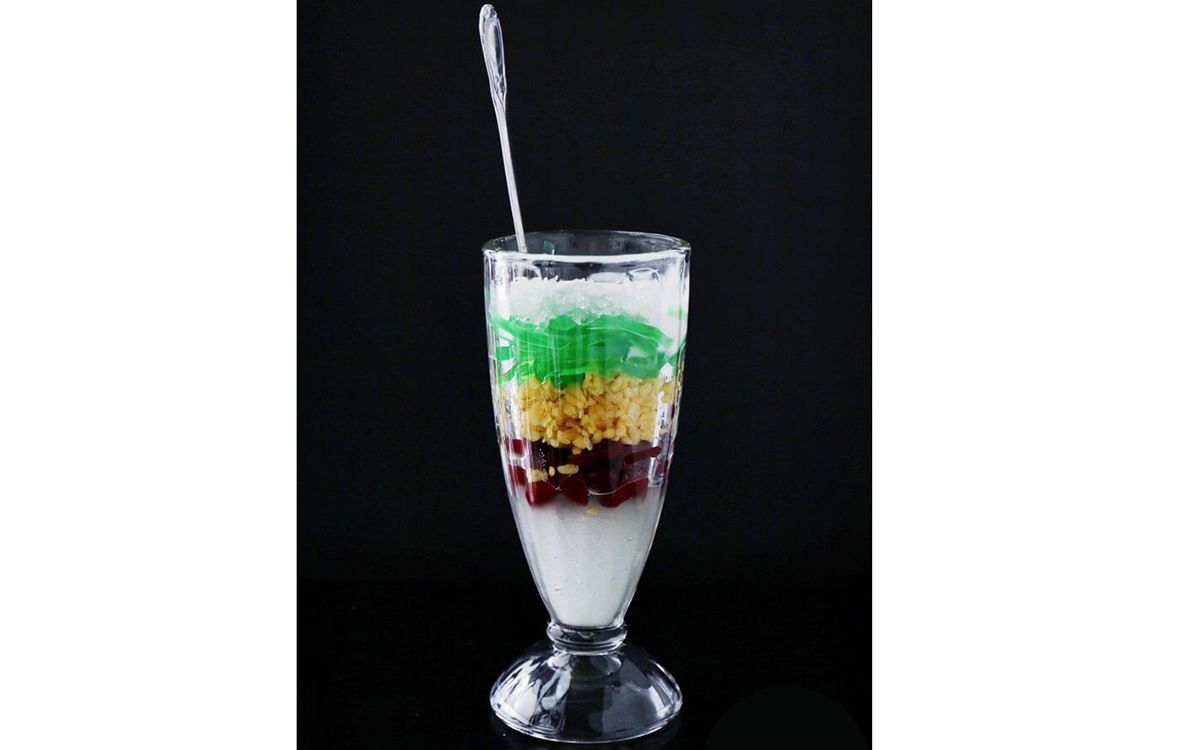
INGREDIENTS
-
1/2 cup split, hulled mung beans, soaked overnight
Pandan jelly layer:
-
1 tbsp agar agar powder
-
2 tbsp sugar
-
2 cups water
-
3 drops pandan flavoring
Sugar syrup:
-
1/2 sugar
-
1/2 cup water
Sweet coconut cream:
-
1 can of coconut cream (alternatively, you can refrigerate a can of full-fat coconut milk, then take the thick cream)
-
2 tbsp sugar (you can add more if you'd like)
Other layers:
-
1 can red kidney beans (try to find low sodium), rinsed very well and drained
-
2 cups shaved ice
INSTRUCTIONS
-
Soak the split, hulled mung beans (they're yellow) in about 4 cups of water overnight. Alternatively, you can soak them for about 1 hour in warm water before you start making this dessert; it's better when soaked overnight though. Rinse and drain the next day.
-
Using a steamer, arrange the mung beans on one of the perforated steam layers and steam over medium heat for about 20 minutes or until they're very soft. If you prefer the soft, mung bean mash type texture, you could cook them in a pot in about 1 1/2 cups of water until they're soft. You could then mash with a potato masher or hand blender until you get that really thick texture (adding water as desired).
Pandan jelly layer:
-
In a small pot over medium heat, combine agar agar powder, sugar, and water and stir well until the agar has dissolved (the water will look clear). Stir in the pandan flavoring and then pour into a glass container (you can use one of those glass sandwich ones; I ended up using a glass pie pan). Let cool and set completely in the fridge for about 2 hours.
-
Once those are set, cut into jelly strips (about 1 1/2 inches long and maybe a quarter-inch thick). Set aside.
Sugar syrup:
- In a small pot (or alternatively the microwave), heat sugar and water until sugar is completely dissolved (water will look clear). Set aside to cool.
Sweet coconut cream:
-
Combine the coconut cream and sugar and heat until sugar is dissolved. Set aside.
To assemble:
-
In a tall glass, add 2 to 3 tbsp of crushed or shaved ice, 2 heaping tbsp of the kidney beans, another 2 heaping tbsp of the mung beans, a layer of the pandan jelly, more shaved ice, and 3 tbsp each of the sugar syrup and sweetened coconut cream.
-
Enjoy immediately!
 The Magazine of The Sierra Club
The Magazine of The Sierra Club

